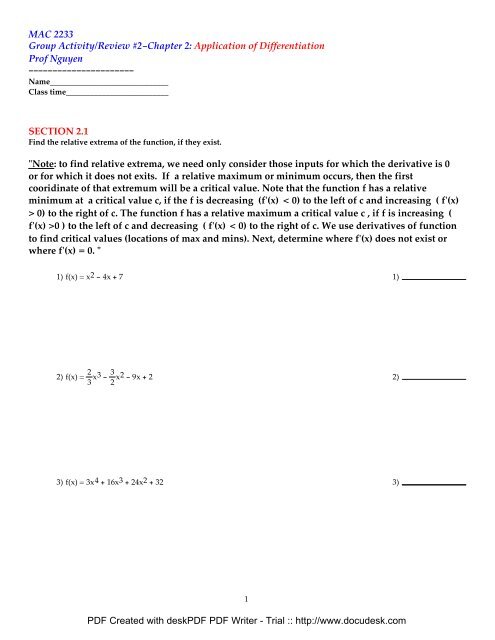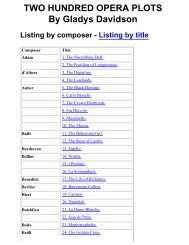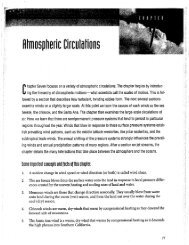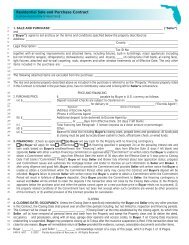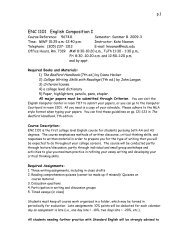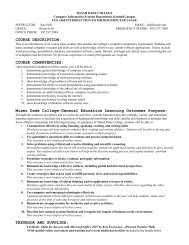Chapter 2 - MDC Faculty Home Pages
Chapter 2 - MDC Faculty Home Pages
Chapter 2 - MDC Faculty Home Pages
Create successful ePaper yourself
Turn your PDF publications into a flip-book with our unique Google optimized e-Paper software.
MAC 2233<br />
Group Activity/Review #2-<strong>Chapter</strong> 2: Application of Differentiation<br />
Prof Nguyen<br />
----------------------<br />
Name______________________________<br />
Class time__________________________<br />
SECTION 2.1<br />
Find the relative extrema of the function, if they exist.<br />
"Note: to find relative extrema, we need only consider those inputs for which the derivative is 0<br />
or for which it does not exits. If a relative maximum or minimum occurs, then the first<br />
cooridinate of that extremum will be a critical value. Note that the function f has a relative<br />
minimum at a critical value c, if the f is decreasing (f'(x) < 0) to the left of c and increasing ( f'(x)<br />
> 0) to the right of c. The function f has a relative maximum a critical value c , if f is increasing (<br />
f'(x) >0 ) to the left of c and decreasing ( f'(x) < 0) to the right of c. We use derivatives of function<br />
to find critical values (locations of max and mins). Next, determine where f'(x) does not exist or<br />
where f'(x) = 0. "<br />
1) f(x) = x2 - 4x + 7 1)<br />
2) f(x) = 2<br />
3 x3 - 3<br />
2 x2 - 9x + 2 2)<br />
3) f(x) = 3x4 + 16x3 + 24x2 + 32 3)<br />
1<br />
PDF Created with deskPDF PDF Writer - Trial :: http://www.docudesk.com
4) f(x) = (x + 5)2/3 + 3 4)<br />
MULTIPLE CHOICE. Choose the one alternative that best completes the statement or answers the question.<br />
Find the location and value of all relative extrema for the function.<br />
5)<br />
6)<br />
A) Relative minimum of 0 at 0.<br />
B) Relative minimum of -2 at -3 ; Relative maximum of 2 at 3.<br />
C) None<br />
D) Relative minimum of -2 at -3 ; Relative minimum of 0 at 0 ; Relative maximum of 2 at 3.<br />
A) Relative minimum of -1 at -3.<br />
B) Relative minimum of 3 at 3 ; Relative minimum of 0 at 0 ; Relative maximum of -3 at -3.<br />
C) Relative minimum of 3 at 3 ; Relative maximum of -3 at -3.<br />
D) None<br />
2<br />
PDF Created with deskPDF PDF Writer - Trial :: http://www.docudesk.com<br />
5)<br />
6)
7)<br />
8)<br />
A) None<br />
B) Relative minimum of 0 at 0.<br />
C) Relative maximum of 5 at -2 ; Relative maximum of 1 at 2.<br />
D) Relative maximum of 5 at -2 ; Relative minimum of 0 at 0 ; Relative maximum of 1 at 2.<br />
A) Relative maximum of 2 at 1.<br />
B) Relative minimum of -1 at -2.<br />
C) Relative minimum of 1 at 2 ; Relative maximum of -1 at -2.<br />
D) None<br />
Graph the function by first finding the relative extrema.<br />
9) f(x) = x3 + 2x2 - x - 2<br />
12<br />
8<br />
4<br />
y<br />
-6 -4 -2 2 4 6<br />
-4<br />
-8<br />
-12<br />
x<br />
3<br />
PDF Created with deskPDF PDF Writer - Trial :: http://www.docudesk.com<br />
9)<br />
7)<br />
8)
10) h(x) = x4 - 2x2 + 1<br />
8<br />
4<br />
y<br />
-5 -4 -3 -2 -1 1 2 3 4 5<br />
11) f(x) = x2/3 + 3<br />
6<br />
4<br />
2<br />
-4<br />
-8<br />
y<br />
-5 5<br />
-2<br />
-4<br />
-6<br />
x<br />
x<br />
MULTIPLE CHOICE. Choose the one alternative that best completes the statement or answers the question.<br />
Section 2.2<br />
Find f"(x) for the function.<br />
12) f(x) = 8x2 + 3x - 3<br />
A) 16x + 3 B) 16 C) 0 D) 8<br />
13) f(x) = 3x4 - 8x2 + 4<br />
A) 12x2 - 16 B) 36x2 - 16x C) 36x2 - 16 D) 12x2 - 16x<br />
4<br />
PDF Created with deskPDF PDF Writer - Trial :: http://www.docudesk.com<br />
10)<br />
11)<br />
12)<br />
13)
14) f(x) = x2 + x<br />
A) 2x3/2 - 1<br />
x3/2<br />
1<br />
15) f(x) =<br />
x2 - 1<br />
A) 6x2 - 2<br />
(x2 - 1)3<br />
B) 8x3/2 + 1<br />
4x3/2<br />
B) 6x2 - 2<br />
(x2 - 1)4<br />
Find the requested value of the second derivative of the function.<br />
16) f(x) = x4 + 4x3 - 2x + 5; Find f′′ (1).<br />
C) 8x3/2 - 1<br />
4x3/2<br />
C) 6x2 + 2<br />
(x2 - 1)3<br />
D) 2x3/2 + 1<br />
x3/2<br />
D) 6x2 + 2<br />
(x2 - 1)4<br />
A) 36 B) 31 C) 40 D) -35<br />
17) f(x) = 7x2 + 6x - 3; Find f′′ (0).<br />
A) 14 B) 7 C) 0 D) -14<br />
5<br />
PDF Created with deskPDF PDF Writer - Trial :: http://www.docudesk.com<br />
14)<br />
15)<br />
16)<br />
17)
NOTE:<br />
* Test for Concavity<br />
-If f"(x) >0 on an interval I, then the graph of f is concave up. (f' is increasing, so f is turning up<br />
on I).<br />
-If f"(x)
20) f(x) = 2x3 + 3x2 - 12x - 2<br />
A) Relative minimum: - 1 11<br />
,<br />
2 4<br />
B) Relative minimum: -2, 3 , relative maximum: 1, - 3<br />
2<br />
C) Relative maximum: -2, 3 , relative minimum: 1, - 3<br />
2<br />
D) Relative maximum: 1 21<br />
, -<br />
2 4<br />
21) f(x) = (x - 5)2/3<br />
A) Relative minimum: (5, 0) B) Relative minimum: (-5, 0)<br />
C) Relative maximum: (-5, 0) D) There are no relative extrema.<br />
22) f(x) = 20x3 - 3x5<br />
A) Relative minimum: (-2, -64), relative maximum at (0,0)<br />
B) Relative maximum at (0,0), relative minimum: ( 2, 64)<br />
C) Relative minimum: (-2, -64), relative minimum at (0,0), relative maximum: ( 2, 64)<br />
D) Relative minimum: (-2, -64), relative maximum: (2, 64)<br />
Identify the intervals where the function is changing as requested.<br />
23) Increasing<br />
A) (-3, 3) B) (-2, 2) C) (-2, ∞) D) (-3, ∞)<br />
7<br />
PDF Created with deskPDF PDF Writer - Trial :: http://www.docudesk.com<br />
20)<br />
21)<br />
22)<br />
23)
24) Decreasing<br />
A) (2, -1) B) (-1, 2) C) (1, 2) D) (2, 1)<br />
25) Increasing<br />
A) (1, 5) B) (1, 6) C) (0, 6) D) (0, 5)<br />
26) Decreasing<br />
A) (3, ∞) B) (0, 3) C) (-1, 0) D) (-∞, 0)<br />
Determine where the given function is increasing and where it is decreasing by using the Second -Derivative Test<br />
27) f(x) = 2x3 - 9x2 + 12x<br />
A) Increasing on (-∞, 1], decreasing on [1, ∞)<br />
B) Decreasing on (-∞, 0] and [2, ∞), increasing on [0, 2]<br />
C) Increasing on (-∞, 1] and [2, ∞), decreasing on [1, 2]<br />
D) Decreasing on (-∞, 1] and [2, ∞), increasing on [1, 2]<br />
8<br />
PDF Created with deskPDF PDF Writer - Trial :: http://www.docudesk.com<br />
24)<br />
25)<br />
26)<br />
27)
Determine where the given function is increasing and where it is decreasing.<br />
28) f(x) = -4x2 - 2x - 12<br />
A) Increasing on -∞, 1<br />
4<br />
B) Increasing on -∞, - 1<br />
4<br />
C) Increasing on -∞, - 1<br />
4<br />
D) Decreasing on -∞, - 1<br />
4<br />
1<br />
, decreasing on , ∞<br />
4<br />
1<br />
, decreasing on - , ∞<br />
4<br />
1<br />
and (0, ∞), decreasing on - , 0<br />
4<br />
1<br />
, increasing on - , ∞<br />
4<br />
Determine where the given function is increasing and where it is decreasing by using the Second -Derivative Test<br />
29) f(x) = (x + 3)2/3 - 6<br />
A) Increasing on (-∞, -3], decreasing on [-3, ∞)<br />
B) Decreasing on (-∞, ∞)<br />
C) Decreasing on (-∞, -3], increasing on [-3, ∞)<br />
D) Decreasing on (-∞, -3] and [0, ∞), increasing on [-3, 0)<br />
Determine where the given function is increasing and where it is decreasing.<br />
30) f(x) = x4 - 18x2 + 4<br />
A) Increasing on (-∞, -3] and [0, 3], decreasing on [-3, 0] and [3, ∞)<br />
B) Increasing on (-∞, -3] and [3, ∞), decreasing on [-3, 3]<br />
C) Decreasing on (-∞, -3] and [3, ∞), increasing on [-3, 3]<br />
D) Decreasing on (-∞, -3] and [0, 3], increasing on [-3, 0] and [3, ∞)<br />
Find the points of inflection.<br />
31) f(x) = x3 - 3x2 + 2x + 15<br />
A) (-1, -3) B) (1, -1) C) (1, 15) D) (1, -3)<br />
9<br />
PDF Created with deskPDF PDF Writer - Trial :: http://www.docudesk.com<br />
28)<br />
29)<br />
30)<br />
31)
32) f(x) = 4<br />
3 x3 - 12x2 + 10x + 46<br />
A) (3, 0) B) (3, -26) C) (3, 4) D) (0, 4)<br />
33) f(x) = (x + 2)2/3 - 7<br />
A) (-2, -7), (0, 22/3 - 7) B) (-2, -7)<br />
C) (0, 22/3 - 7) D) No points of inflection exist<br />
Find the largest open intervals where the function has the indicated concavity.<br />
34) Concave upward<br />
A) (0, ∞) B) (0, 3) C) (-3, ∞) D) (-3, 3)<br />
35) Concave upward<br />
A) (-∞, 0) B) (0, ∞) C) None D) (-∞, 0), (0, ∞)<br />
36) Concave downward<br />
A) (-1, 0) , (1, ∞) B) (-∞, -1) C) (-1, 0) D) (0, 1)<br />
10<br />
PDF Created with deskPDF PDF Writer - Trial :: http://www.docudesk.com<br />
32)<br />
33)<br />
34)<br />
35)<br />
36)
Suppose that the function with the given graph is not f(x), but f′(x). Find the open intervals where the function is<br />
concave upward or concave downward, and find the location of any inflection points.<br />
37)<br />
38)<br />
120<br />
80<br />
40<br />
y<br />
-5 -4 -3 -2 -1<br />
-40<br />
1 2 3 4 5<br />
-80<br />
-120<br />
x<br />
A) Concave upward on (-∞, 0); concave downward on (0, ∞); inflection point at 0<br />
B) Concave upward on (-∞, -2) and (2, ∞); concave downward on (-2, 2); inflection points at -2<br />
and 2<br />
C) Concave upward on (-2, 2); concave downward on ( -∞, -2) and (2, ∞); inflection points at -2<br />
and 2<br />
D) Concave upward on (-∞, -2) and (2, ∞); concave downward on (-2, 2); inflection points at<br />
-120 and 120<br />
8<br />
6<br />
4<br />
2<br />
y<br />
-5 -4 -3 -2 -1 1 2 3 4 5<br />
-2<br />
-4<br />
-6<br />
-8<br />
x<br />
A) Concave upward on (-∞, -1) and (0, 1); concave downward on ( -1, 0) and (1, ∞; ); inflection<br />
points<br />
at -1, 0, and 1<br />
B) Concave upward on (-1, 0) and (1, ∞); concave downward on (-∞, -1) and (0, 1); inflection<br />
points<br />
at -4, 0, and 4<br />
C) Concave upward on (-∞, 0); concave downward on (0, ∞); inflection point at 0<br />
D) Concave upward on (-1, 0) and (1, ∞); concave downward on (-∞, -1) and (0, 1); inflection<br />
points<br />
at -1, 0, and 1<br />
11<br />
PDF Created with deskPDF PDF Writer - Trial :: http://www.docudesk.com<br />
37)<br />
38)
Determine where the given function is concave up and where it is concave down.<br />
39) f(x) = x3 + 3x2 - x - 24 39)<br />
40) G(x) = 1<br />
4 x4 - x3 + 5 40)<br />
41) f(x) = (x + 3)2/3 - 6 41)<br />
Graph the function.<br />
42) f(x) = x3 + x2 - 5x - 5<br />
10<br />
y<br />
-5 5<br />
-10<br />
x<br />
12<br />
PDF Created with deskPDF PDF Writer - Trial :: http://www.docudesk.com<br />
42)
MULTIPLE CHOICE. Choose the one alternative that best completes the statement or answers the question.<br />
Solve the problem.<br />
43) The annual revenue and cost functions for a manufacturer of grandfather clocks are approximately<br />
R(x) = 500x - 0.01x2 and C(x) = 160x + 100,000, where x denotes the number of clocks made. What<br />
is the maximum annual profit?<br />
A) $2,890,000 B) $2,990,000 C) $3,090,000 D) $2,790,000<br />
44) The percent of concentration of a certain drug in the bloodstream x hr after the drug is<br />
administered is given by K(x) = 5x<br />
. How long after the drug has been administered is the<br />
x2 + 4<br />
SECTION 2.3<br />
concentration a maximum? Round answer to the nearest tenth, if necessary.<br />
A) 2 hr B) 0.2 hr C) 5 hr D) 0.4 hr<br />
Determine the vertical asymptote(s) of the given function. If none exists, state that fact.<br />
x + 4<br />
45) g(x) =<br />
x2 - 1<br />
A) x = -1, x = 1 B) x = -1, x = 1, x = -4<br />
C) x = 1, x = -4 D) x = 0, x = 1<br />
x + 9<br />
46) f(x) =<br />
x2 + 1<br />
A) x = -1, x = -9 B) x = -1, x = 1, x = -9<br />
C) x = -1, x = 1 D) none<br />
-3x2<br />
47) R(x) =<br />
x2 + 6x - 55<br />
A) x = - 55 B) x = -11, x = 5, x = -3<br />
C) x = -11, x = 5 D) x = 11, x = -5<br />
x - 1<br />
48) R(x) =<br />
x3 + 3x2 - 40x<br />
A) x = -8, x = 5 B) x = -8, x = 0, x = 5<br />
C) x = -5, x = -30, x = 8 D) x = -5, x = 0, x = 8<br />
13<br />
PDF Created with deskPDF PDF Writer - Trial :: http://www.docudesk.com<br />
43)<br />
44)<br />
45)<br />
46)<br />
47)<br />
48)
Determine the horizontal asymptote of the given function. If none exists, state that fact.<br />
49) g(x) = x2 + 4x - 8<br />
x - 8<br />
50) h(x) =<br />
A) y = 8 B) y = 0<br />
C) y = 1 D) no horizontal asymptotes<br />
8x - 3<br />
x - 5<br />
A) y = 8 B) y = 5<br />
C) y = 0 D) no horizontal asymptotes<br />
51) h(x) = 2x3 - 6x<br />
3x3 - 7x + 5<br />
A) y = 0 B) y = 2<br />
3<br />
C) y = 6<br />
7<br />
52) h(x) = 7x4 - 8x2 - 4<br />
6x5 - 2x + 2<br />
A) y = 0 B) y = 4<br />
C) y = 7<br />
6<br />
Find the indicated intercept(s) of the graph of the function.<br />
53) y-intercept of f(x) = x2 - 11x + 4<br />
x2 + 8x + 2<br />
D) no horizontal asymptotes<br />
D) no horizontal asymptotes<br />
A) (0, 2) B) (0, 8) C) (0, 4) D) none<br />
54) y-intercept of f(x) = x3 + 2<br />
x2 + 2<br />
A) (0, 3) B) (0, 1) C) (0, 2) D) none<br />
55) x-intercepts of f(x) =<br />
2x + 3<br />
x - 6<br />
A) - 3<br />
3<br />
, 0 B) , 0 C) (6, 0) D) (-6, 0)<br />
2 2<br />
x - 4<br />
56) x-intercepts of f(x) =<br />
x2 + 6x - 2<br />
A) (4, 0) B) (6, 0) C) (-4, 0) D) none<br />
14<br />
PDF Created with deskPDF PDF Writer - Trial :: http://www.docudesk.com<br />
49)<br />
50)<br />
51)<br />
52)<br />
53)<br />
54)<br />
55)<br />
56)
(x - 3)(2x + 5)<br />
57) x-intercepts of f(x) =<br />
x2 + 6x - 4<br />
A) (-3, 0), 5<br />
5<br />
, 0 B) (3, 0), - , 0 C) (3, 0), (-5, 0) D) none<br />
2 2<br />
58) x-intercepts of f(x) = x2 - x - 20<br />
x2 + 5<br />
.<br />
A) (-5, 0), (4, 0) B) (-4, 0), (5, 0) C) (- 20, 0) D) (-5, 0), (0, 0)<br />
Graph the rational function.<br />
x - 1<br />
59) f(x) =<br />
x + 2<br />
x<br />
60) f(x) =<br />
x2 - 25<br />
y<br />
x<br />
15<br />
PDF Created with deskPDF PDF Writer - Trial :: http://www.docudesk.com<br />
59)<br />
60)<br />
57)<br />
58)
x - 3<br />
61) f(x) =<br />
x2 - 9<br />
MULTIPLE CHOICE. Choose the one alternative that best completes the statement or answers the question.<br />
SECTION 2.4<br />
Find the absolute maximum and absolute minimum values of the function, if they exist, over the indicated interval, and<br />
indicate the x-values at which they occur.<br />
62) f(x) = 9 + 2x - x2; [0, 3]<br />
10<br />
8<br />
6<br />
4<br />
2<br />
y<br />
1 2 3<br />
x<br />
A) Absolute maximum = 8 at x = 2; absolute minimum = 6 at x = 0<br />
B) Absolute maximum = 11 at x = 1; absolute minimum = 6 at x = 3<br />
C) Absolute maximum = 10 at x = 1; absolute minimum = 6 at x = 3<br />
D) Absolute maximum = 10 at x = 1; absolute minimum = 9 at x = 0<br />
16<br />
PDF Created with deskPDF PDF Writer - Trial :: http://www.docudesk.com<br />
61)<br />
62)
Find the absolute maximum and absolute minimum values of the function, if they exist, over the indicated interval, and<br />
indicate the x-values at which they occur.<br />
63) f(x) = 6x<br />
; [-3, 3]<br />
63)<br />
x2 + 1<br />
3<br />
y<br />
-3 3 x<br />
-3<br />
A) Absolute maximum = 1.8 at x = 1; absolute minimum = -1.8 at x = -1<br />
B) Absolute maximum = 3 at x = 1; absolute minimum = -3 at x = -1<br />
C) Absolute maximum = 1.8 at x = -1; absolute minimum = 0 at x = 0<br />
D) Absolute maximum = 3 at x = 1; absolute minimum = 0 at x = 0<br />
Find the absolute maximum and absolute minimum values of the function, if they exist, over the indicated interval.<br />
When no interval is specified, use the real line ( -∞, ∞).<br />
64) f(x) = 1<br />
3 x3 - 4x; [-8, 8]<br />
64)<br />
A) Absolute maximum: 416<br />
416<br />
, absolute minimum: -<br />
3 3<br />
B) Absolute maximum: 5.33, absolute minimum: -5.33<br />
C) Absolute maximum: 5.33, absolute minimum: - 416<br />
3<br />
D) Absolute maximum: 416<br />
, absolute minimum: -5.33<br />
3<br />
17<br />
PDF Created with deskPDF PDF Writer - Trial :: http://www.docudesk.com
Find the absolute maximum and absolute minimum values of the function, if they exist, on the indicated interval.<br />
65) f(x) = x4 - 32x2 + 2; [-5, 5]<br />
A) Absolute maximum: 0, absolute minimum: -254<br />
B) Absolute maximum: -254<br />
C) Absolute minimum: 0<br />
D) Absolute maximum: 2, absolute minimum: -254<br />
66) f(x) = -x2 + 6x - 9 : [3, 3]<br />
A) Absolute maximum: 0; absolute minimum: 0<br />
B) Absolute maximum: 18; absolute minimum: 0<br />
C) Absolute maximum: 0; absolute minimum: 1<br />
4<br />
D) Absolute maximum: 1; absolute minimum: 0<br />
67) F(x) = 3 x ; [0, 8]<br />
A) Absolute maximum: 2, absolute minimum: -2<br />
B) Absolute maximum: 8, absolute minimum: 0<br />
C) Absolute maximum: 0, absolute minimum: -2<br />
D) Absolute maximum: 2, absolute minimum: 0<br />
18<br />
PDF Created with deskPDF PDF Writer - Trial :: http://www.docudesk.com<br />
65)<br />
66)<br />
67)
Find the absolute maximum and absolute minimum values of the function, if they exist, over the indicated interval.<br />
When no interval is specified, use the real line ( -∞, ∞).<br />
68) f(x) = x2 + 16<br />
; (0, ∞)<br />
68)<br />
x<br />
200<br />
y<br />
14 x<br />
A) No absolute maximum; absolute minimum: 2<br />
B) No absolute maximum; absolute minimum: 12<br />
C) Absolute maximum: 196; absolute minimum: 2<br />
D) No absolute extrema<br />
69) f(x) = x4 - 4x2<br />
12<br />
8<br />
4<br />
y<br />
-4 4 x<br />
-4<br />
-8<br />
-12<br />
-16<br />
-20<br />
A) Absolute maximum: 0; absolute minimum: -4<br />
B) Absolute maximum: 0; no absolute minimum<br />
C) No absolute maximum; absolute minimum: -4<br />
D) No absolute extrema<br />
70) f(x) = - 1<br />
3 x3 + 16x - 1; (-∞, 0)<br />
A) Absolute maximum: 4; absolute minimum: -4<br />
B) No absolute maximum; absolute minimum: -43.7<br />
C) Absolute minimum: -41.7; absolute maximum: 43.7<br />
D) No absolute extrema<br />
19<br />
PDF Created with deskPDF PDF Writer - Trial :: http://www.docudesk.com<br />
69)<br />
70)
71) f(x) = 4x + 8<br />
Solve the problem.<br />
A) Absolute maximum: 8; no absolute minimum<br />
B) Absolute maximum: 4; no absolute minimum<br />
C) No absolute maximum; absolute minimum: 4<br />
D) No absolute extrema<br />
72) Assume that the temperature T of a person during a certain illness is given by<br />
T(t) = -0.1t2 + 1.3t + 98.6, 0 ≤ t ≤ 12 where T = the temperature (°F) at time t, in days. Find the<br />
maximum value of the temperature and when it occurs. Round your answer to the nearest tenth,<br />
if necessary.<br />
A) 102.8°F at 6.5 days B) 101.3°F at 5.2 days<br />
C) 101.8°F at 6.5 days D) 102.8°F at 3.9 days<br />
73) The total-revenue and total-cost functions for producing x clocks are R(x) = 520x - 0.01x2 and<br />
C(x) = 120x + 100,000, where 0 ≤ x ≤ 25,000. What is the maximum annual profit?<br />
A) $4,100,000 B) $4,200,000 C) $4,000,000 D) $3,900,000<br />
20<br />
PDF Created with deskPDF PDF Writer - Trial :: http://www.docudesk.com<br />
71)<br />
72)<br />
73)
74) P(x) = -x3 + 27<br />
2 x2 - 60x + 100, x ≥ 5 is an approximation to the total profit (in thousands of dollars)<br />
from the sale of x hundred thousand tires. Find the number of tires that must be sold to maximize<br />
profit.<br />
A) 550,000 B) 500,000 C) 500,000 D) 450,000<br />
75) In a certain state, the rate (per 500,000 inhabitants) at which automobiles were stolen each year<br />
during the years 1990 - 2000 are given in the figure. Consider the closed interval [1990, 2000].<br />
Rate per 500K People<br />
300<br />
250<br />
200<br />
150<br />
100<br />
50<br />
A<br />
B<br />
C<br />
D<br />
E<br />
F<br />
1990 1992 1994 1996 1998 2000<br />
Year<br />
A (1990, 171) D (1993, 282) G (1996, 188) L (1999, 238)<br />
B (1991, 204) E (1994, 211) H (1997, 258) M (2000, 271)<br />
C (1992, 255) F (1995, 141) K (1998, 247)<br />
Give all relative maxima and minima on the interval and the years when they occur.<br />
A) Relative maxima of 282 in 1993, 258 in 1997, 271 in 2000<br />
Relative minima of 171 in 1990, 141 in 1995, 238 in 1999<br />
B) Relative maxima of 282 in 1993 and 258 in 1997<br />
Relative minima of 141 in 1995 and 238 in 1999<br />
C) Relative maxima of 282 in 1993, 258 in 1997, 271 in 2000<br />
Relative minima of 141 in 1995 and 238 in 1999<br />
D) Relative maxima of 282 in 1993 and 258 in 1997<br />
Relative minima of 171 in 1990, 141 in 1995, 238 in 1999<br />
G<br />
H<br />
21<br />
PDF Created with deskPDF PDF Writer - Trial :: http://www.docudesk.com<br />
K<br />
L<br />
M<br />
74)<br />
75)
SECTION 2.5<br />
Solve the problem.<br />
76) A carpenter is building a rectangular room with a fixed perimeter of 420 ft. What are the<br />
dimensions of the largest room that can be built? What is its area?<br />
A) 210 ft by 210 ft; 44,100 ft2 B) 42 ft by 378ft; 15,876 ft2<br />
Solve the problem.<br />
C) 105 ft by 105 ft; 11,025 ft2 D) 105 ft by 315 ft; 33,075 ft2<br />
77) A company wishes to manufacture a box with a volume of 40 cubic feet that is open on top and is<br />
twice as long as it is wide. Find the width of the box that can be produced using the minimum<br />
amount of material. Round to the nearest tenth, if necessary.<br />
A) 3.2 ft B) 3.6 ft C) 6.4 ft D) 7.2 ft<br />
78) Find the number of units that must be produced and sold in order to yield the maximum profit,<br />
given the following equations for revenue and cost:<br />
R(x) = 60x - 0.5x2<br />
C(x) = 4x + 7.<br />
A) 63 units B) 57 units C) 56 units D) 64 units<br />
22<br />
PDF Created with deskPDF PDF Writer - Trial :: http://www.docudesk.com<br />
76)<br />
77)<br />
78)
79) Find the maximum profit given the following revenue and cost functions:<br />
R(x) = 108x - x2<br />
C(x) = 1<br />
3 x3 - 3x2 + 96x + 36<br />
where x is in thousands of units and R(x) and C(x) are in thousands of dollars.<br />
A) 108 thousand dollars B) 72 thousand dollars<br />
C) 18 thousand dollars D) 36 thousand dollars<br />
80) An appliance company determines that in order to sell x dishwashers, the price per dishwasher<br />
must be<br />
p = 600 - 0.4x.<br />
It also determines that the total cost of producing x dishwashers is given by<br />
C(x) = 3000 + 0.2x2.<br />
What is the maximum profit?<br />
A) $147,000 B) $153,000 C) $150,000 D) $297,000<br />
81) A hotel has 230 units. All rooms are occupied when the hotel charges $110 per day for a room. For<br />
every increase of x dollars in the daily room rate, there are x rooms vacant. Each occupied room<br />
costs $34 per day to service and maintain. What should the hotel charge per day in order to<br />
maximize daily profit?<br />
A) $177 B) $187 C) $170 D) $77<br />
23<br />
PDF Created with deskPDF PDF Writer - Trial :: http://www.docudesk.com<br />
79)<br />
80)<br />
81)
82) If the price charged for a candy bar is p(x) cents, then x thousand candy bars will be sold in a<br />
certain city, where p(x) = 49 - x<br />
. How many candy bars must be sold to maximize revenue?<br />
22<br />
A) 539 thousand candy bars B) 1078 candy bars<br />
C) 539 candy bars D) 1078 thousand candy bars<br />
83) A baseball team is trying to determine what price to charge for tickets. At a price of $10 per ticket,<br />
it averages 40,000 people per game. For every increase of $1, it loses 5,000 people. Every person at<br />
the game spends an average of $5 on concessions. What price per ticket should be charged in<br />
order to maximize revenue?<br />
A) $13.50 B) $3.00 C) $3.50 D) $6.50<br />
84) SECTION 2.6<br />
A company estimates that the daily revenue (in dollars) from the sale of x cookies is given by<br />
R(x) = 885 + 0.02x + 0.0003x2.<br />
Currently, the company sells 900 cookies per day. Use marginal revenue to estimate the increase in<br />
revenue if the company increases sales by one cookie per day.<br />
A) $92.00 B) $0.56 C) $0.92 D) $56.00<br />
24<br />
PDF Created with deskPDF PDF Writer - Trial :: http://www.docudesk.com<br />
82)<br />
83)<br />
84)
85) A company finds that when it spends x million dollars on advertising, its profit P, in thousands of<br />
dollars, is given by<br />
P(x) = 970 + 15x - 4x2<br />
Currently the company spends 17 million dollars on advertising. Use the marginal profit to<br />
estimate the change in profit if the company increases its advertising expenditure by one million<br />
dollars.<br />
A) -121 thousand dollars B) 970 thousand dollars<br />
C) 119 thousand dollars D) 255 thousand dollars<br />
86) Suppose that the daily cost, in dollars, of producing x televisions is<br />
C(x) = 0.003x3 + 0.1x2 + 62x + 620,<br />
and currently 60 televisions are produced daily. Use C(60) and the marginal cost to estimate the<br />
daily cost of increasing production to 63 televisions daily. Round to the nearest dollar.<br />
A) $5673 B) $5635 C) $5481 D) $5667<br />
Section 2.7<br />
Differentiate implicitly to find the slope of the curve at the given point.<br />
87) y3 + yx2 + x2 - 3y2 = 0; (-1, 1)<br />
A) 3<br />
2<br />
88) xy3 - x5y2 = -4; (-1, 2)<br />
A) - 6<br />
5<br />
B) -1 C) -2 D) - 1<br />
2<br />
B) - 3<br />
2<br />
25<br />
C) - 3<br />
4<br />
D) 2<br />
3<br />
PDF Created with deskPDF PDF Writer - Trial :: http://www.docudesk.com<br />
85)<br />
86)<br />
87)<br />
88)
89) xy + x = 2; (1, 1)<br />
A) 2 B) - 2 C) 1<br />
2<br />
Find dy/dx by implicit differentiation.<br />
90) xy2 = 4<br />
A) 2x<br />
y<br />
91) y2 - xy + x2 = 7<br />
2x - y<br />
A)<br />
x + 2y<br />
92) x3 + y3 = 8<br />
A) x2<br />
y2<br />
93) y3 + 5xy + 4x3 - 4x = 0<br />
4 + 5y - 12x2<br />
A)<br />
3y2 - 5x<br />
B) - y<br />
2x<br />
B)<br />
2x + y<br />
x - 2y<br />
B) - y2<br />
x2<br />
4 - 5y - 12x2<br />
B)<br />
3y2 - 5x<br />
26<br />
C) x<br />
2y<br />
C)<br />
2x + y<br />
x + 2y<br />
C) y2<br />
x2<br />
C)<br />
4 - 5y - 12x2<br />
3y2 + 5x<br />
D) - 1<br />
2<br />
D) - 2y<br />
x<br />
D)<br />
2x - y<br />
x - 2y<br />
D) - x2<br />
y2<br />
D)<br />
4 + 5y - 12x2<br />
3y2 + 5x<br />
PDF Created with deskPDF PDF Writer - Trial :: http://www.docudesk.com<br />
89)<br />
90)<br />
91)<br />
92)<br />
93)
94) 9x3 - x2y3 = 7<br />
A) 27x2 - 2xy2<br />
xy2<br />
Calculate dy/dt using the given information.<br />
95) x3 + y3 = 9; dx/dt = -3, x = 1, y = 2<br />
A) - 3<br />
4<br />
B) 27x2 - 2xy2<br />
3x2y2<br />
B) 4<br />
3<br />
96) xy + x = 12; dx/dt = -3, x = 2, y = 5<br />
Solve the problem.<br />
C) 27x2 - 2xy3<br />
3x2y2<br />
C) 3<br />
4<br />
D) 27x2 - 2xy3<br />
3xy2<br />
D) - 4<br />
3<br />
A) 3 B) -9 C) 9 D) -3<br />
97) Given the revenue and cost functions R = 34x - 0.4x2 and C = 4x + 9, where x is the daily<br />
production, find the rate of change of revenue with respect to time when x = 15 units and<br />
dx<br />
= 7 units per day.<br />
dt<br />
A) $204.4 per day B) $198 per day C) $154 per day D) $126 per day<br />
27<br />
PDF Created with deskPDF PDF Writer - Trial :: http://www.docudesk.com<br />
94)<br />
95)<br />
96)<br />
97)
98) Given the revenue and cost functions R = 30x - 0.3x2 and C = 3x + 13, where x is the daily<br />
production, find the rate of change of profit with respect to time when x = 10 units and<br />
dx<br />
= 8 units per day.<br />
dt<br />
A) $168 per day B) $192 per day C) $211.2 per day D) $210 per day<br />
99) A heart attack victim is given a blood vessel dilator to increase the radii of the blood vessels. After<br />
receiving the dilator, the radii of the affected blood vessels increase at about 2% per minute.<br />
According to Poiseulle's law, the volume of blood flowing through a vessel and the radius of the<br />
vessel are related by the formula V = kr4 where k is a constant. What will be the percentage rate of<br />
increase in the blood flow after the dilator is given?<br />
A) 8%/min B) 6%/min C) 12%/min D) 10%/min<br />
100) A zoom lens in a camera makes a rectangular image on the film that is 8 cm length x 5 cm width.<br />
As the lens zooms in and out, the size of the image changes. Find the rate at which the area of the<br />
image begins to change (dA/df) if the length of the frame changes at 0.5 cm/s and the width of the<br />
frame changes at 0.1 cm/s.<br />
A) 3.3 cm2/s B) 8<br />
5 cm2/2 C) 0.66 cm2/s D) 4.5 cm2/s<br />
28<br />
PDF Created with deskPDF PDF Writer - Trial :: http://www.docudesk.com<br />
98)<br />
99)<br />
100)
Answer Key<br />
Testname: MAC2233-GA-CHP2<br />
1) Relative minimum at (2, 3)<br />
2) Relative maximum at - 3 79<br />
41<br />
, ; relative minimum at 3, -<br />
2 8 2<br />
3) Relative minimum at (0, 32)<br />
4) Relative minimum at (-5, 3)<br />
5) B<br />
6) D<br />
7) B<br />
8) C<br />
9)<br />
10)<br />
11)<br />
12) B<br />
13) C<br />
14) C<br />
12<br />
8<br />
4<br />
y<br />
-6 -4 -2 2 4 6<br />
-4<br />
-8<br />
-12<br />
8<br />
4<br />
y<br />
-5 -4 -3 -2 -1 1 2 3 4 5<br />
6<br />
4<br />
2<br />
-4<br />
-8<br />
y<br />
-5 5<br />
-2<br />
-4<br />
-6<br />
x<br />
x<br />
x<br />
29<br />
PDF Created with deskPDF PDF Writer - Trial :: http://www.docudesk.com
Answer Key<br />
Testname: MAC2233-GA-CHP2<br />
15) C<br />
16) A<br />
17) A<br />
18) A<br />
19) D<br />
20) C<br />
21) A<br />
22) D<br />
23) B<br />
24) C<br />
25) D<br />
26) C<br />
27) C<br />
28) B<br />
29) C<br />
30) D<br />
31) C<br />
32) C<br />
33) D<br />
34) A<br />
35) B<br />
36) A<br />
37) B<br />
38) D<br />
39) Concave up on (-1, ∞), concave down on (-∞, -1)<br />
40) Concave up on (-∞, 0) and (2, ∞), concave down on (0, 2)<br />
41) Concave down on (-∞, -3) and (-3, ∞)<br />
42)<br />
43) D<br />
44) A<br />
45) A<br />
46) D<br />
47) C<br />
48) B<br />
49) D<br />
50) A<br />
51) B<br />
52) A<br />
10<br />
y<br />
-5 5<br />
-10<br />
x<br />
30<br />
PDF Created with deskPDF PDF Writer - Trial :: http://www.docudesk.com
Answer Key<br />
Testname: MAC2233-GA-CHP2<br />
53) A<br />
54) B<br />
55) A<br />
56) A<br />
57) B<br />
58) B<br />
59)<br />
60)<br />
61)<br />
62) C<br />
63) B<br />
64) A<br />
65) D<br />
66) A<br />
12<br />
8<br />
4<br />
y<br />
-12 -8 -4 4 8 12 x<br />
-4<br />
-8<br />
-12<br />
5<br />
y<br />
-10 10<br />
-5<br />
4<br />
2<br />
-6 -4 -2 2 4 6<br />
-2<br />
-4<br />
x<br />
31<br />
PDF Created with deskPDF PDF Writer - Trial :: http://www.docudesk.com
Answer Key<br />
Testname: MAC2233-GA-CHP2<br />
67) D<br />
68) B<br />
69) C<br />
70) B<br />
71) D<br />
72) A<br />
73) D<br />
74) C<br />
75) A<br />
76) C<br />
77) A<br />
78) C<br />
79) D<br />
80) A<br />
81) B<br />
82) A<br />
83) D<br />
84) B<br />
85) A<br />
86) D<br />
87) C<br />
88) B<br />
89) B<br />
90) B<br />
91) D<br />
92) D<br />
93) C<br />
94) C<br />
95) C<br />
96) C<br />
97) C<br />
98) A<br />
99) A<br />
100) A<br />
32<br />
PDF Created with deskPDF PDF Writer - Trial :: http://www.docudesk.com


